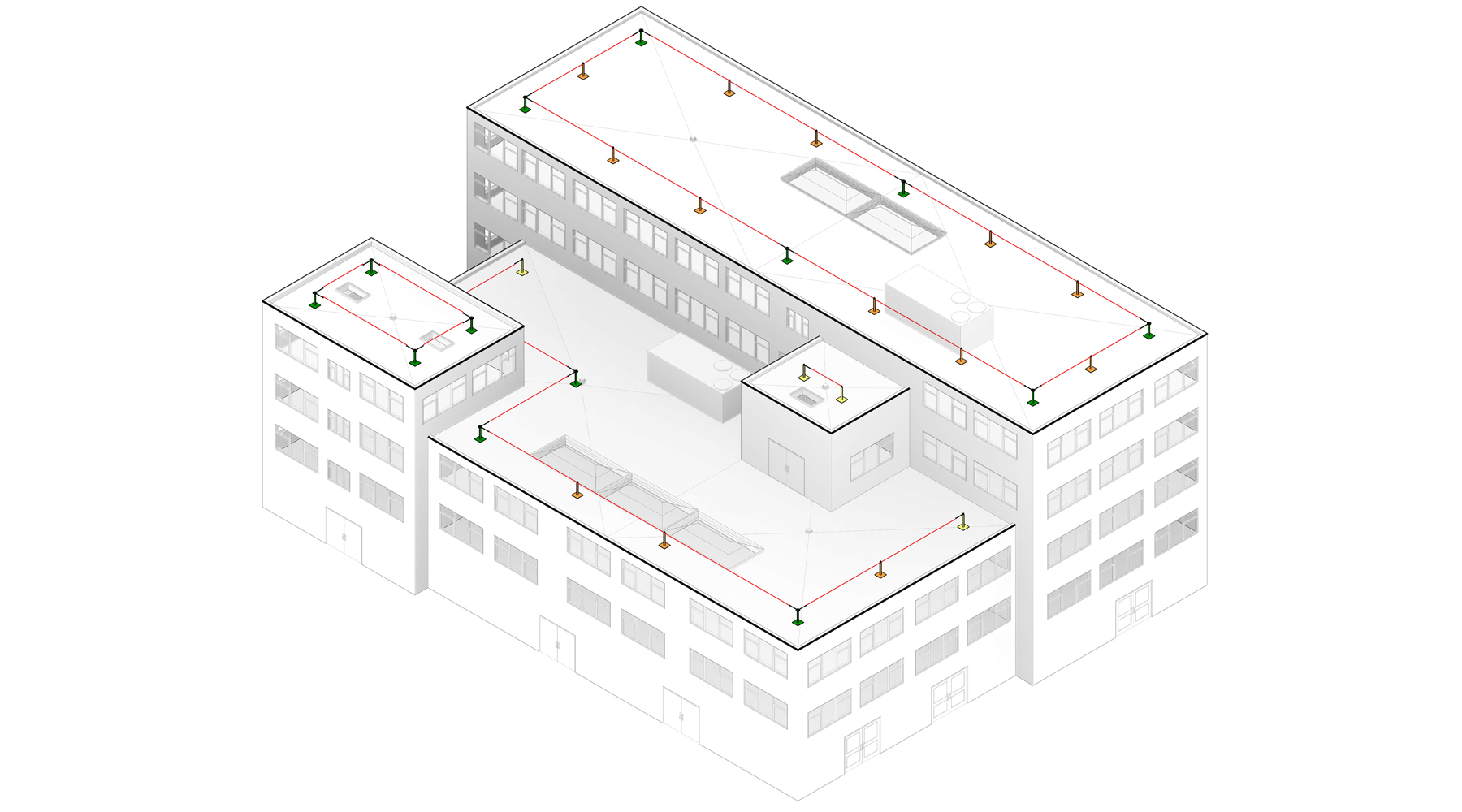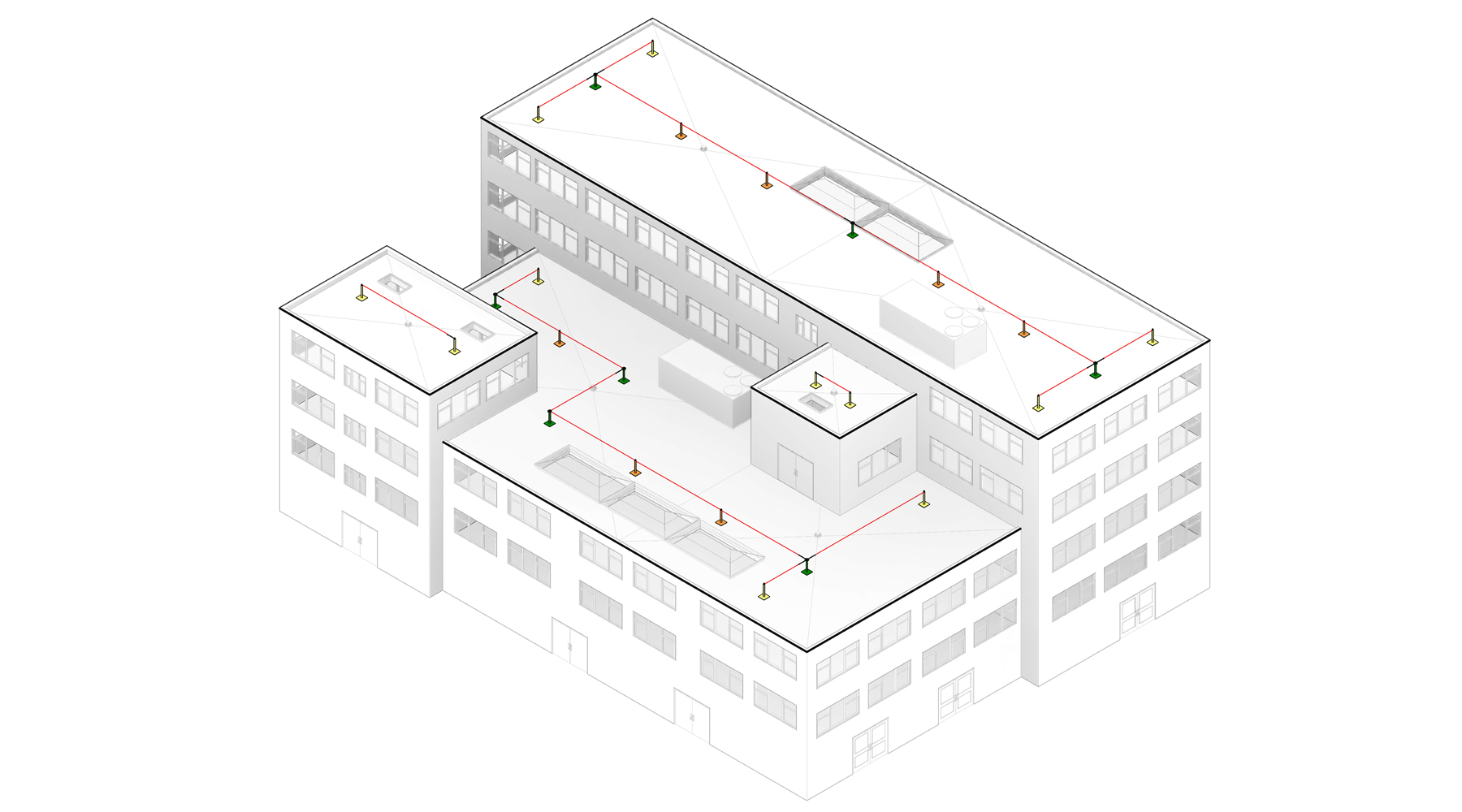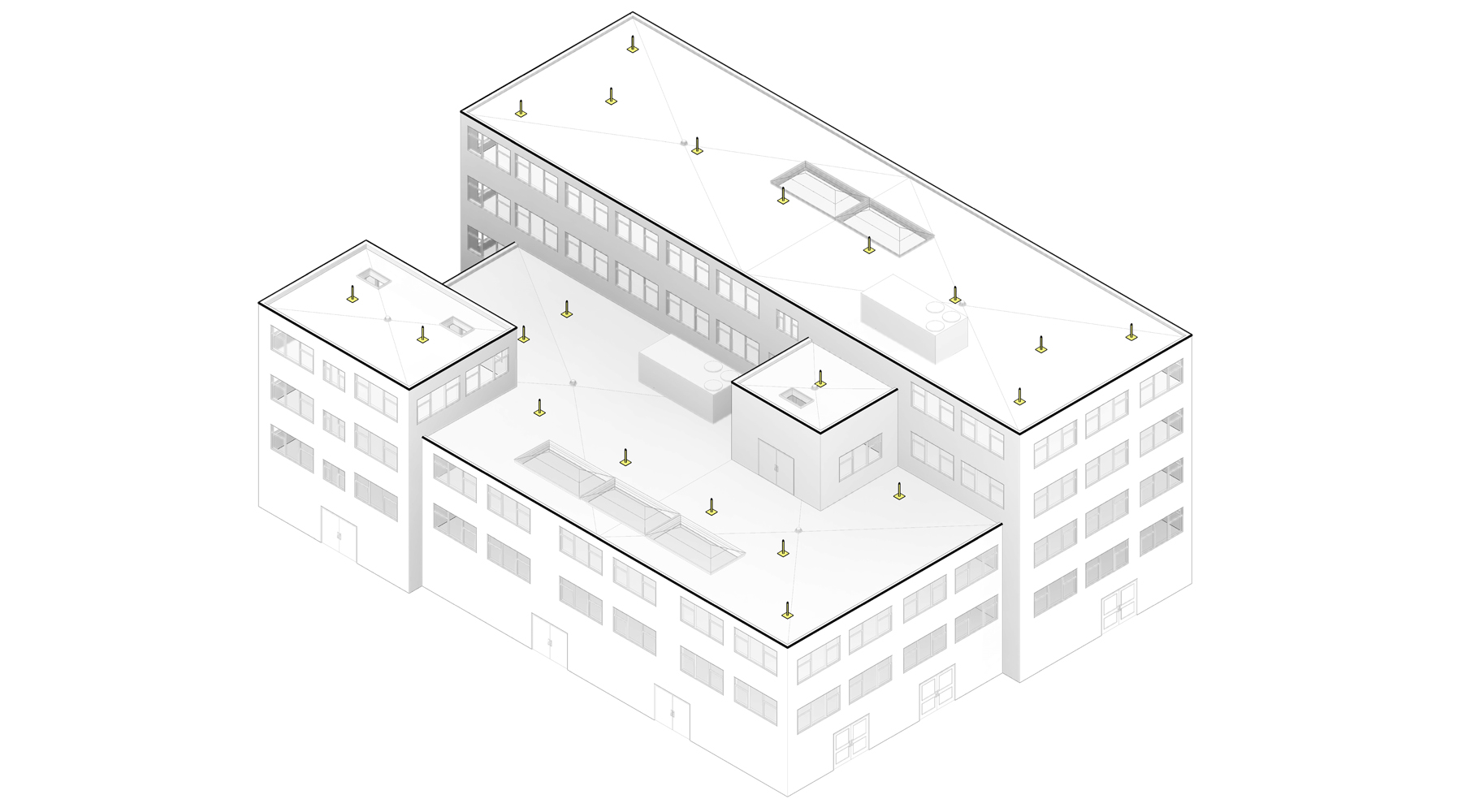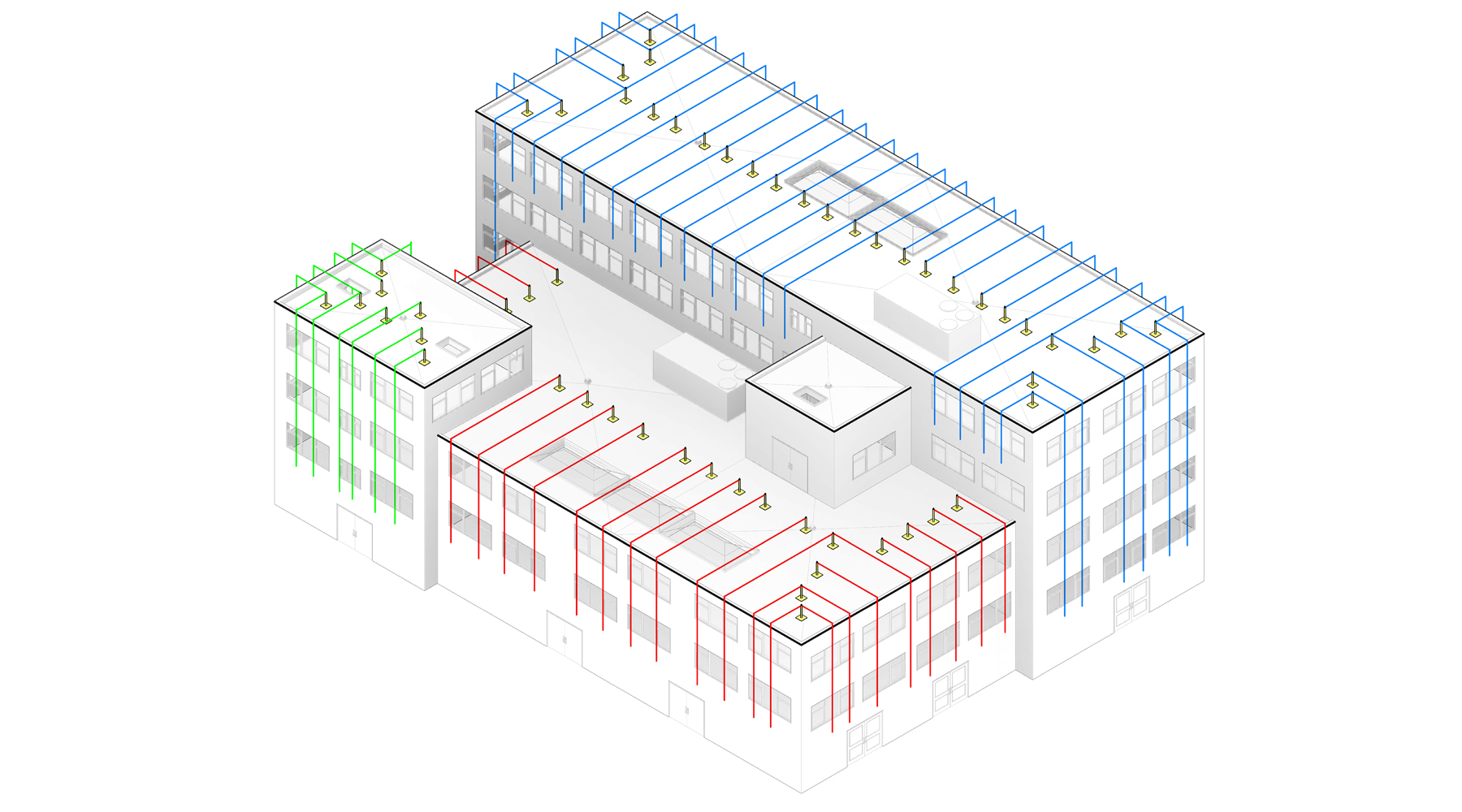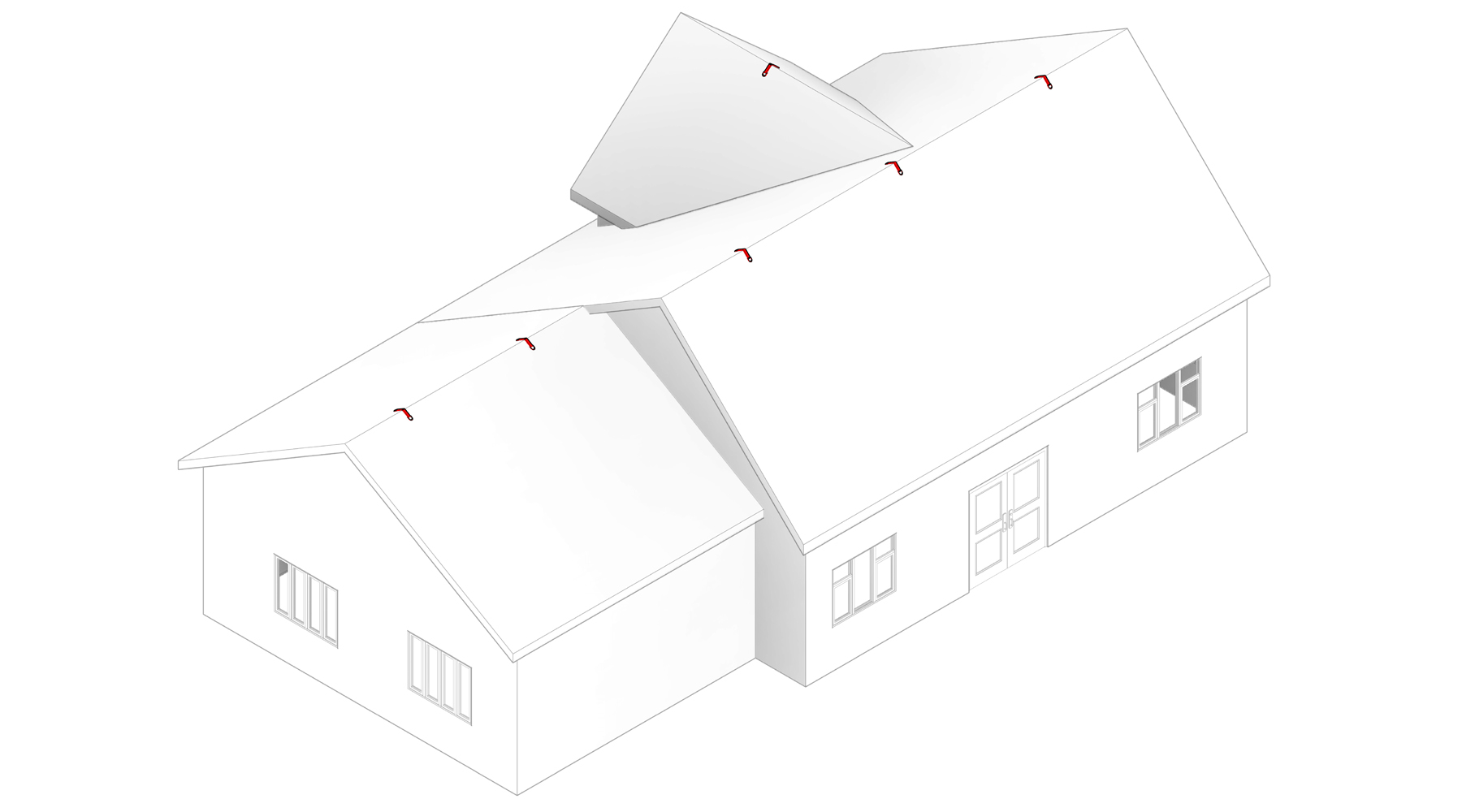CRA Project Starter – Fall Protection Information
The information below is here to help you design your Commercial Roof Anchor (CRA) fall protection system and better understand this information. Super Anchor has spent the last 5+ years developing the tools needed by architects, engineers, general contractors, and others to specify a complete, pre-engineered fall protection system for low slope and high slope roofs. No expense has been spared and all products are backed by extensive third-party documentation. We have listened to design professionals across the country and are excited to introduce our fall protection systems to you. Seven main points outlined below will help educate, explain, and inspire you to design a fall arrest system for your project:
#1 – Understanding and Choosing your Anchor Layout. There are three basic rooftop anchor layouts, two window washing layout options and an assortment of interior and exterior wall/floor/ceiling layouts. It is important to note the layout and anchor selection for window washing suspension have unique factors independent of fall protection anchors (see the Window Washing Anchor Overview). We have provided a brief description and picture of the different layouts here:
- Building Rooftop Perimeter Cable System: This system places anchors in from the leading edge approximately 10’ and anchors are spaced every 20’ – 30’ on center. A 3/8” galvanized or stainless-steel cable is attached to the anchors. This is considered a horizontal lifeline (HLL) system. Cable lengths up to 120’ long are possible. If the run is longer, we can use a CRA with a 4-Way Top where the HLL can be terminated. The following HLL run can also be started from the same 4-way top. We have a “pass-thru” top on the intermediate CRA anchors that allow a worker to pass through the top of the CRA. A HLL rigging kit is installed on each CRA run and consists of everything needed to install the cable as per OSHA guidelines. The perimeter fall protection system is a popular roof anchor safety layout. The close proximity of the HLL to the leading edge allows the workers to use a lanyard, lifeline or self-retracting lifeline to be attached to the cable and securely hold them while working at or near the edge of the roof.
- Building Rooftop Centerline Cable System: This system has anchors placed at or near the building centerline lengthwise. The ends of the centerline system terminate onto another horizontal lifeline system attached at a 90-degree angle thus making an “H” type layout. The centerline system utilizes less anchors than the perimeter system and allows the worker to use a lifeline or self-retracting lifeline to reach the edge of the roof. This is a very popular choice for many flat/low slope commercial roofs. Many lifelines and self-retracting lifelines are 50’ long (longer lengths are available), so for buildings wider than 100’ it may be prudent to go with a perimeter-based system.
- Stand Alone Anchor Point: The stand-alone anchors are anchors installed permanently and do not have cable connecting them together. This is a very popular choice due to the simplicity as the anchors are installed and offer a 360-degree protection radius for those tied off to it. Anchors should be placed strategically so that the worker does not fall more than 6’ from the roof edge. The anchor service zone radiuses should overlap at the leading edge to provide 100% fall protection for anyone working on the roof.
- Window Washing & Suspended Maintenance Anchor Overview: Fall Protection Anchors and Window Washing Suspension/Façade Access/Suspended Maintenance anchors have different criteria regarding their design load, testing load and certification requirements. These anchors are subjected to continuous loading and must be capable of enduring without weakening. Our anchors are IWCA Compliant (International Window Cleaners Association) for window washing anchorages. Here is a brief synopsis of the code:
- IWCA I-14.1 (9.1.1). Anchorages shall be capable of sustaining a 5,000 lb. minimum load or a minimum 4-to-1 factor of safety, whichever is greater, in any direction the load is applied. (SAS Note: a 4:1 safety factor would be a 1,250-pound max load as 1,250 x 4 = 5,000 pounds).
- IWCA I-14.1 (8.1.3(b)). For post-installation testing…an anchorage with an ultimate capacity of 5,000 pounds…shall be tested at 2,500 pounds.
- IWCA I-14.1 (9.1.10). Certification and recertification of anchorages shall be under the supervision of a registered professional engineer.
The regulatory difference between the Fall Protection and Window Washing Anchors is important to keep in mind: Window Washing anchors have a working load of 1,250 pounds and an allowable proof load of 2,500 pounds; fall arrest anchors do not. Since the service and proof loading and certification requirements are different for window washing anchors it is important to have us help you with the layout.
Anchor installation requirements specific to window washing anchor layouts:
-
- CRA’s must be bolted to the structure.
- Maximum Anchor Spacing is 12’-0” (this is achieved at 44’-9” from the leading edge with a maximum 15-degree angle from perpendicular).
- Maximum distance from the roof edge is 60 feet.
- Each worker must be tied off to two independent anchors.
- While suspended, a window cleaner shall not reach further than 6’ to his left or 6’ to his right. This gives a 12’ wide working width.
- Maximum angle from perpendicular is 15-degrees for both suspension rope and fall arrest rope.
- Anchors need to be placed in line with the work area without obstructions.
- Anchors should be placed at least 6’ back from the leading edge if possible. A perimeter guard or personal fall arrest system is required when installing or rigging to an anchor within 6’ of a leading edge.
- Window Washing Anchor Layout – Centerline: Window washing anchor layouts require special consideration (for projects in California, please see our CRO line of anchors) because window washing suspension requires the worker to tie off to two anchors points at the same time. The first anchor is the suspension anchor, and the second anchor is the safety lifeline anchor or redundant anchor in case the first should fail. A building centerline window washing system will consist of CRA’s installed at closer intervals than normal due to the unique circumstances needed. The centerline system is preferred because the anchors can service more than one side of the building. Even with a centerline system there are going to be areas where anchors will need to be installed to reach certain drop zones that will be close to the edge of the roof. Mechanical units can also pose a problem for centerline systems.
- Window Washing Anchor Layout – Individual Drop Zones: Our most popular window washing layout is individual drop zones for the windows (for projects in California, please see our CRO line of anchors). Each zone needs two anchors – the first anchor is the suspension anchor, and the second anchor is the safety lifeline anchor or redundant anchor in case the first should fail. The window layout will determine where the anchors will need to be placed up on the roof top and care will need to be taken to avoid mechanical equipment and other obstructions. Some window washing anchors may be installed on the wall of the building or even under pavers on patio decks.
- Wall, Ceiling and Floor Anchors for Interior and Exterior – Anchor Considerations: Fall protection anchors can also be installed onto walls, ceilings and floors. Exterior wall mounted anchors can be installed in lieu of roof anchors, especially in areas with minimal roof area. Floor mounted anchors are especially useful in interior applications installed near exterior windows that need cleaning from the inside of the building, elevator shafts that need servicing or exterior decks that need maintenance. The anchor base is installed onto the structure and a temporary anchor is screwed into the base unit. When not in use a special stainless-steel cap is screwed into the base for a professional finished aesthetic. Remember: fall hazards should be addressed on all aspects of the building for worker safety.
After determining the anchor layout for your project, choose the CRA anchor that best fits your needs. For example, a Perimeter System would normally include: CRA End Anchors, 4-Way Top Anchors, Pass-Thru Top Anchors as Horizontal Lifeline Rigging Kits. Next, pick a riser height that penetrates through the roofing substrate with enough riser height exposure to flash into the roofing system. Our stock riser heights are 12”, 18” and 24”. Need help in determining your system or have questions? Please reach out to us and we can help you.
#2 – Fall Protection Anchor Installations. CRA anchors are typically installed as a permanent fixture on the structure. This allows anyone to utilize it for fall protection safety especially after the project is complete. Our CRA anchors can be proof loaded to make sure that the anchor and installation hardware will sustain a force load. NOTE: by design, not all anchors can be proof loaded. It is not a requirement to do so unless they are going to be used for window washing applications. Our line of Commercial Roof Anchors are designed to be proof loaded to certain force loads depending on what application they will be utilize for:
| FALL ARREST ANCHORS | WINDOW WASHING ANCHORS | |
|---|---|---|
| Working Load: | Not applicable | 1,250 pounds |
| Allowable proof load: | No requirement | 2,500 pounds maximum |
| Allowable Proof Load California: | No requirement | 5,000 pounds zero deformation |
| Ultimate Load (no certification): | 5,000 pounds | 5,000 pounds |
| Ultimate Load (with certification): | 2:1 safety factor | 5,000 pounds |
Anchors can be mechanically fastened by screws, bolts, wedge anchors, all-thread and epoxy fasteners. The installer must consult the instruction and specification for each anchor to determine what fastener must be used for your specific application. NOTE: all window washing suspension anchors cannot be installed with screws of any sort. The must be secured by a bolt, weld, wedge-anchor or epoxy bolt.
#3 – Meeting the OSHA Requirements for Safety. Falls from roofs and leading edges to lower levels injure and kill more people that anything else on the jobsite and it is an OSHA requirement to provide protection from falls to all employees – 29 CFR 1926 subpart M for Fall Protection, standard 501 Duty to have fall protection: https://www.osha.gov/laws-regs/regulations/standardnumber/1926/1926.501. What are the safety and health regulations for construction? In a nutshell: if there is a free fall exposure 6 feet or greater there is a duty to provide fall protection. The standard applies to all commercial and residential employees regardless of their trade.
- 1029:501(b)(1) “Unprotected sides and edges.” Each employee on a walking/working surface (horizontal and vertical surface) with an unprotected side or edge which is 6 feet (1.8 m) or more above a lower level shall be protected from falling by the use of guardrail systems, safety net systems, or personal fall arrest systems.
- 1926:501(b)(2)(i) Each employee who is constructing a leading edge 6 feet (1.8 m) or more above lower levels shall be protected from falling by guardrail systems, safety net systems, or personal fall arrest systems. Exception: When the employer can demonstrate that it is infeasible or creates a greater hazard to use these systems, the employer shall develop and implement a fall protection plan which meets the requirements of paragraph (k) of 1926.502.
Note: There is a presumption that it is feasible and will not create a greater hazard to implement at least one of the above-listed fall protection systems. Accordingly, the employer has the burden of establishing that it is appropriate to implement a fall protection plan which complies with 1926.502(k) for a particular workplace situation, in lieu of implementing any of those systems.
- 1926:501(b)92)(ii) Each employee on a walking/working surface 6 feet (1.8 m) or more above a lower level where leading edges are under construction, but who is not engaged in the leading edge work, shall be protected from falling by a guardrail system, safety net system, or personal fall arrest system. If a guardrail system is chosen to provide the fall protection, and a controlled access zone has already been established for leading edge work, the control line may be used in lieu of a guardrail along the edge that parallels the leading edge.
OSHA lists three ways to provide active fall protection systems as seen above:
- Guardrail/Scaffolding systems.
- Netting systems
- Personal Fall Arrest systems.
Each has advantages and disadvantages. The first two work well during the construction phase usually in conjunction with some sort of personal fall arrest system. When the building is finished the OSHA regulations still apply long after the guardrails, netting and scaffolding have been removed, so installing permanent anchors provides a lasting solution to the fall protection problem. Our anchors are tested to the most stringent requirements and are guaranteed to perform when installed properly.
#4 – Provide a Solid Specification and BIM Tools. Super Anchor is the basis of design for the “Facilities Fall Protection” 118129 specification. This specification is ready to be utilized in your library for all future projects. We have also provided designers BIM content to be able to design the CRA systems onto their projects. These powerful tools give you the confidence to specify our anchors on your projects. Super Anchor Safety MasterSpec link: https://products-specpoint.mydeltek.com/products/all/?groupby=sectionNumber%2520false%252CproductType%2520false&sortby=sectionNumber%252CproductType%252Ctype%252ClastUpdated%2520desc&ia=true&defaultFilter=true&df=%27Super+Anchor+Safety%27%25%7C%25%27Super+Anchor+Safety%27
#5 – Aesthetics vs. Safety. We know aesthetics are extremely important to designers. Parapets vs. railings vs. anchors can pose unique problems and issues. Many of our anchors are very low profile and will not be visible from the ground level. Our residential style anchors are specifically designed to blend into the roofing material and can be painted to match the color of the roof. Exterior anchors can also be designed by you to meet specific aesthetic requirements by utilizing BIM/Revit. We even have interior fall protection anchors that are sub-surface and covered by a special cover to blend into the floor, wall or ceiling surface.
#6 – A Trusted Fall Protection Source. We have over 27 years of experience manufacturing fall protection equipment so you can feel comfortable specifying our equipment. We offer an industry-leading product warranty as well as product-liability insurance certificates to back up every anchor that we sell. All anchors come with comprehensive instruction manuals, permanent warning labels, design, engineering and testing data on our website. System training is accomplished through the best Instruction manuals available anywhere in the world. Rest assured that you are getting “The Best in Fall Arrest” when you choose Super Anchor Safety.
#7 – Anchor Terms & Fall Protection Information. We call anchors exactly that – anchors. But you may know them as Tie Backs, Davits, Safety Anchors, Roof Anchor, Tie Back Anchors, Fall Arrest Anchors, Fall Arrest Points, Fall Prevention Anchors, Fall Protection Posts and more. Although called many different things, we will simply refer to them as CRA’s or anchors. They are generally permanently installed anchors designed to keep people from contacting the ground or other structure in the event of a fall over the edge of the roof or structure. All our anchors are designed and engineered to withstand the forces exerted on them caused by the acceleration of the users’ weight by the forces of gravity. Time, distance, weight, and speed create force load impacts that may surprise you. These numbers show us why OSHA and ANSI utilize certain numbers in their standards and regulations and why we keep the total free fall must be 6’ or less. OSHA and ANSI fall protection standards and regulations can be found on their websites. The following information is based on a 180-pound worker carrying 20 pounds of tools subject to a free fall:
| Time in seconds: | Distance in feet: | Speed Achieved: | Force Load: |
|---|---|---|---|
| 0.25 seconds | 1′ traveled | 5.5 miles per hour | 440 pounds force at impact |
| 0.50 seconds | 4′ traveled | 11 miles per hour | 1,600 pounds force at impact |
| 0.75 seconds | 9′ traveled | 16 miles per hour | 3,600 pounds force at impact |
| 1.00 second | 16′ traveled | 22 miles per hour | 6,400 pounds force at impact |
| 1.50 seconds | 36′ traveled | 33 miles per hour | 14,000 pounds force at impact |
| 1.75 seconds | 49′ traveled | 38 miles per hour | 19,600 pounds force at impact |
These numbers stress a couple of important factors: it takes less than 1 second of free fall to generate enough force to severely harm or kill a person. To be sure, gravity is not a force to be taken for lightly.
Fall protection definitions can be found online at www.osha.gov but we want to make just a few important ones available to you here. These four definitions are very important and will help you understand what is required in the fall protection system design and hierarchy:
- FALL RESTRAINT: no free fall of any distance. The worker is restrained from reaching a fall hazard by keeping his personal fall arrest system rigged or adjusted in such a way that he cannot reach the leading edge.
- FALL ARREST: the form of fall protection which involves the safe stopping of a person already falling. Personal Fall Arrest is the most common type of fall arrest and consists of a full body harness, energy absorber, vertical lifeline with rope grab, self-retracting lifeline, and anchorage connector.
- QUALIFIED PERSON: a qualified person is an individual “who, by possession of a recognized degree, certificate or professional standing, or who by extensive knowledge, training and experience, has successfully demonstrated his ability to solve or resolve problems relating to the subject matter, the work or the project.” A qualified person has the knowledge and expertise to determine fall protection clearances, loads, anchor layouts and install or supervise installation of fall protection systems. They are responsible for design and installation of the fall protection system.
- COMPETENT PERSON: a competent person is an individual “who is capable of identifying existing and predictable hazards in the surrounding or working conditions which are unsanitary, hazardous or dangerous to employees, and who has authorization to take prompt, corrective measures to eliminate them.” A competent person is an employee who must have authority to take prompt measures to eliminate hazards and can take corrective measures on the job site. They are responsible for the safe use of the fall protection system.
- AUTHORIZED PERSON: an authorized person means a person approved or assigned by the employer to perform a specific type of duty or duties or to be at a specific location or locations at the job site. Within the realm of fall protection, an Authorized Person is anyone who is required by their employer to be exposed to a fall hazard. These will be under the assumption that they will be exposed to fall hazards.
OSHA and ANSI standards reference many numbers that require our attention, and some have multiple definitions. The following will help users, engineers, designers, safety professionals and others to understand what the numbers represent for their circumstances. The following definitions, while not comprehensive, will help you understand how the numbers affect various design situations. This list does not cover everything but is a great start to understanding and explaining them:
- 5,000 pounds.
- Definition 1: Anchor Strength. This is the prescriptive number from OSHA for all fall protection equipment that is not part of an engineered system. They simply took 2,500 pounds (the amount of force for a 220-pound worker falling 6′ with no energy absorber) and added a safety factor of 2. A 5,000-pound load is achievable in certain circumstances but not typically on 2×4 truss structures. Anchors that are “designed, installed and used under the supervision of a qualified person, as part of a complete personal fall protection system that maintain a safety factor of at least two…”. Two times the intended applied load ranges from 900-1,200 pounds during fall arrest. An “engineered system” with a safety factor of two can range from 1,800-2,400 pounds which is far below the often mandatory 5,000-pound anchor point.
- Definition 2: Anchor Strength. ANSI: 5,000 pounds. ANSI’s fall protection standard requires anchorage connector breaking strength for non-certified anchors.
- Definition 3: Zero anchor deformation requirement for Cal-OSHA installed fall protection anchor devices used for window washing suspension. Anchors that are pull tested on the structure to 5,000 pounds must not deform on any axis.
- Definition 4: Strength Requirement. Minimum breaking strength for Vertical Lifelines, Lanyards, Connectors, Hardware, SRL’s that have a 2’+ free fall distance.
- 3,600 pounds. Anchor Strength. This is the OSHA “2 times maximum load” number. They achieved this by taking 1,800 pounds (the maximum allowed amount of force load that can be exerted on a worker falling 6′) and applied a safety factor of 2 (1,800 x 2 = 3,600).
- 3,000 pounds.
- Definition 1: Anchor Strength. ANSI’s work positioning mode of fall protection required anchorage connector breaking strength for non-certified anchors. Fall restraint allows up to a 2’ free fall
- Definition 2: Minimum tensile load for SRL’s that limit free fall to under 2’.
- 2,500 pounds. Anchor Strength – Proof Loading Test. This is a proof-load testing number for CRA anchors that will be used for window washing suspension. Proof-loading cannot exceed 2,500 pounds and the anchor must not have any deformation. This is performed by an engineering firm that specializes in testing installed fall arrest anchors. The CRA must be bolted to the structure to achieve these loads without deformation.
- 2,500 PSI. Concrete structure strength. This is the minimum pounds-per-square-inch (PSI) strength for cured concrete that will be utilized to install anchorage points.
- 1,800 pounds. Anchor Strength & Fall Arrest Forces. This is the engineered system number that many designers use as part of the OSHA “engineered system intended load”. They say that the anchor point must withstand “5,000 pounds or 2 times the intended load in an engineered system”. Our engineering puts the intended load at a maximum of 900 pounds (with the use of a shock/energy absorber in the users fall protection system) of a 310-pound worker falling 6′. 2 times the intended load is 1,800 pounds. No legal fall protection system allows forces more than this number.
- 1,250 pounds.
- Definition 1: Anchor Strength – Proof Loading Test. A testing figure that the CRA anchors are pulled to after installation. This is performed by an engineering firm that specializes in testing installed fall arrest anchors. This load number is utilized on anchors that are installed for fall protection use only and should not be used as a proof load for window washing anchors.
- Definition 2: Anchor Strength. The allowable proof load for anchors that will be utilized for window washing suspension applications.
- Definition 3: 4-1 Design Load for window washing suspension anchors. Anchorage design shall be capable of sustaining a 5,000-pound minimum load or a minimum 4-to-1 safety factor, whichever is greater. This is the number achieved by dividing 5,000 by 4 = 1,250 and used to determine the anchors design meet the 1,250-pound pull test in any direction. IWCA I-14.1-2001 section 9.1.1.
- 1,000 pounds. Anchor Strength. ANSI’s Restraint mode of fall protection minimum required anchorage connector breaking strength for non-certified anchors.
- 900 pounds. Fall Arrest Forces. The maximum average arrest force permitted for our energy absorber (most manufacturers rate their energy absorber to a maximum arresting force of 900 pounds). OSHA and ANSI both allow the maximum arresting force to be 1,800 pounds, though.
- 420 pounds. Worker Capacity. The maximum user weight for those using fall protection when using a heavy-duty energy absorber.
- 340 pounds. Worker Capacity. The maximum permitted worker weight to use fall protection for certain equipment. Manufacture determines this based on their design.
- 310 pounds. Worker Capacity. The maximum permitted worker weight to use fall protection for certain equipment. Manufacturers determine this based on their design.
- 282 pounds. ANSI specified test weight used to determine compliance for fall protection devices. The 282 pounds mimics a 310-pound worker using ANSI’s 1.1:1 weight ratio.
- 200 pounds. Guardrail Strength. The amount of force exerted on a guardrail system without failing.
- 130 pounds. Worker Capacity. The minimum worker weight recommended for someone using fall protection.
- 50 pounds. Guardrail Strength Minimum. The minimum force needed for toe-boards in any downward or outward direction at any point along the toe-board.
Please contact your SAS Sales Rep for more information. We are happy to answer any questions and provide help for you and your team.

